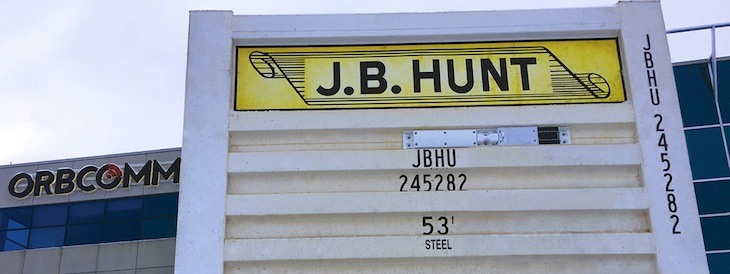J.B. Hunt’s third-quarter earnings to fall, impacted by brokerage segment
by October 2, 2019 1:12 pm 2,768 views

Lowell-based carrier J.B. Hunt Transport Services Inc. is expected to report a decline in earnings per share in the third quarter, and analysts expect the carrier’s brokerage segment will be a drag on earnings.
J.B. Hunt plans to release third-quarter earnings after the markets close Oct. 15. The earnings are expected to fall 2% to $1.44 per share, from $1.47 per share in the same period in 2018, based on a consensus of 21 analysts. Revenue is projected to rise 6.2% to $2.35 billion, from $2.21 billion in the same period in 2018.
In an earnings preview, analysts Justin Long and Jack Atkins and senior associate Brian Colley, all of Little Rock-based Stephens Inc., said J.B. Hunt’s business recently has returned to seasonal levels. They expect third-quarter financial results in its intermodal and dedicated segments, which are its largest, to be in line with expectations, but the carrier’s overall earnings might not meet expectations as a result of headwinds in its brokerage segment, Integrated Capacity Solutions (ICS). The headwinds include a competitive brokerage market and an increase in technology investments.
“As a result, we are trimming our estimates to reflect a more muted outlook for ICS, and would take a less actionable approach buying the stock in the near-term after the 36% rebound from its (year-to-date) low,” the analysts said. They maintained the buy rating and increased the 12-month target stock price by 12.7% to $124, based on a new 2021 estimate.
While the analysts believe that business has increased over the third quarter, peak season has yet to start. They will “wait and see” over the next month. Shippers have provided mixed messages on the demand outlook, but company expectations for peak season likely won’t change, the analysts said.
The analysts expect intermodal volume to rise in one or two months of the third quarter as the carrier projected in the second-quarter earnings call. Long, Atkins and Colley also expect the volumes to rise in the fourth quarter as a whole, and growth will continue into 2020. Pricing for the segment is likely unchanged as bid season was largely completed before the third quarter. As a result, the focus is on 2020, and the trend is uncertain with regard to the unknowns related to peak season and the economy, including the trade negotiations between China and the United States, according to the analysts. Revenue per load is projected to rise by 1.5% in 2020 because of the mix in freight, and pricing is expected to be flat or decline next year.
The carrier’s dedicated segment has a strong pipeline of business, and operating margins in its core dedicated business are expected to be between 11% and 13%, which are within its long-term goal. Excluding the segment’s Final Mile business, which is expected to be separated from the dedicated business in 2020, margins are likely at the higher end of the range. Final Mile operating margins are likely in the low- to mid-single digits, according to Long, Atkins and Colley. The segment is expected to have another good quarter, and operating income could rise in the double digits in 2020 as the company continues to complete conversions of private fleets.
The headwinds in the carrier’s brokerage segment look to be worse than expected, said Long, Atkins and Colley, and this led them to cut their outlook for the segment for not only the third quarter but also for 2019 and 2020.
“To be more specific, this downward revision is predicated on our view that it is an increasingly competitive environment with brokers battling for market share and investments in technology could accelerate sequentially in (the third quarter of 2019),” the analysts said. “As a result, we are now expected (third-quarter 2019) gross margins to be 13.2%, and this is a sequential decline of 20 basis points despite our belief that a tech hiccup served as a (roughly) 150 basis point headwind to gross margins last quarter. Said another way, normalizing for this tech hiccup, this would imply a 170 basis point sequential decline vs. the five-year average sequential change of +20 basis points, (from the second quarter to the third quarter.)”
Also, the segment is expected to have a nearly $5 million operating loss in the second half of 2019, compared to a previously expected profit of about $12 million.
The carrier’s stock has risen about 36% from a low this summer. This is a result of negative investor sentiment in mid-2019, a “better-than-feared” earnings report in the second quarter and signs that demand is becoming more stable — which should lead to a rise in intermodal volumes, said Long, Atkins and Colley. But the stock isn’t expected to rise any more in the short-term with regard to analysts’ expectations for the third quarter. “As a result, we would be more actionable buying on pullbacks associated with various macro uncertainties headed into 2020,” the analysts said. The uncertainties include trade negotiations between the United States and China, the peak season and contract price expectations.
“That said, our view on the long term is unchanged as we feel (J.B. Hunt) is well-positioned structurally in the transportation sector and are encouraged that some of the near-term pressure in ICS results from technology investments will pay dividends longer term as the (technology platform J.B. Hunt 360) rollout continues.”
Shares of J.B. Hunt (NASDAQ: JBHT) were trading Wednesday (Oct. 2) at $106.92, down $1.49, or 1.37%. In the past 52 weeks, the stock has ranged between $122.16 and $83.64.
